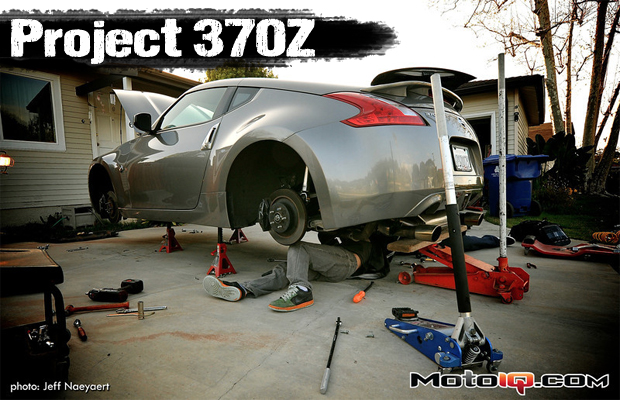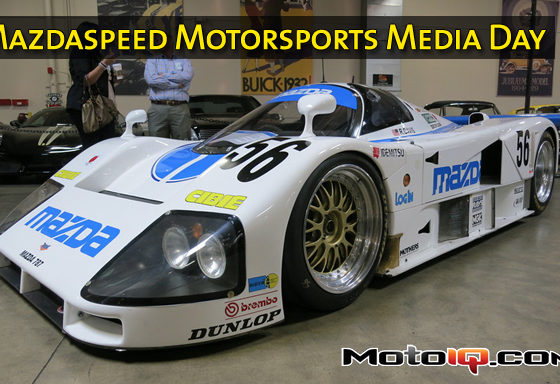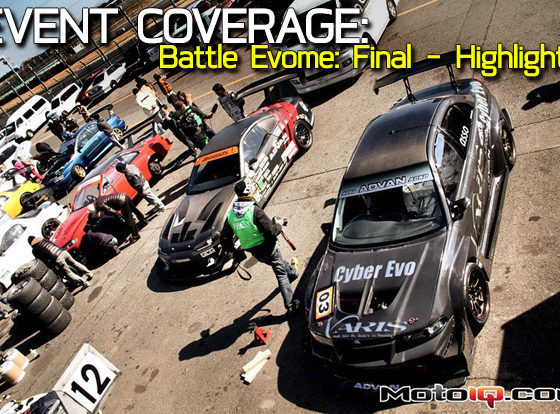,
 |
| The stock shock and upper control arm were pulled to make the installation easier. |
The V3’s have a wide adjusting range, which is very handy for a street/track car like ours. Adjust it softer for street driving on a daily basis and turn up the damping force for track use. A huge advantage that big range of adjustment gets you is that a large range of spring rates can be used to dial in your car’s balance without having to revalve the shocks. The KW’s adjusters also have discrete adjusting increments which are easy to feel when driving. Most adjustable shocks, especially the lower cost ones, do not have consistency in their adjustments. On cheap shocks, the damping force adjusting increments typically vary from click to click and the adjustment range is small.
 |
| The V3’s have OEM style provisions to thoroughly secure the stock front brake lines, a super nice touch. |
Being able to quickly and easily adjust the damping is important. Some double adjustable shocks require disassembly of the shock assembly so a button can be pushed while the shaft is rotated and other lame time consuming methods. The KW’s easy to reach external adjusters make dialing in the chassis a lot easier. Easy adjustment means there is time to make adjustments!
 |
| Putting the shock in place. The V3’s have stainless steel bodies and steel reinforced spring perches which makes them just about corrosion proof, even under salty winter conditions. V3’s have a lifetime warranty, a big plus for a year round daily driver. |
The V3’s damping curve can be tailored from mildly digressive to heavily digressive. A digressive damping curve means that there is more damping at low piston speeds. At higher piston velocities, the two stage valving blows open bypassing fluid to where the damping force stays consistent even as the piston velocity increases. Digressive curves give good body platform control while still allowing a decent ride and minimizing traction reducing tire shock and hop.
 |
| Our front suspension bolted up and ready to go. |
Another cool feature of the KW V3 dampers is that the damper body is shortened so the car can be lowered without losing bump travel. This is an important feature allowing a lower than stock car that will still stay off the bumpstops while cornering with reasonable spring rates. Bottoming under roll when cornering is the #1 cause of ill handling in modified cars so it’s critical not to give up bump travel in a lowered car.




7 comments
Hi Mike and friends,
Great write up on the 370z. I have a 2013 G37s coupe, and am thinking that these KW V3’s are just what I have been looking for, as I don’t want to drop my car much more than an inch. Will I be needing that front A arm to dial in my camber to stock specs, as well as the rear arms? I’m most likely not going to track my car, but who knows,,a guy has to have some fun! I was giving the Bilstein B16 PSS10 kit consideration, but Bilstein said the minimum drop in front was about 2 inches, which might be too low for a street car. How did you access the upper adjusters on the V3’s?
Thanks,
Michael
For an adjustable front arm, I prefer the part made by SPL which was not available when we did this car. If you are not going to track the car, I don’t think its particularly needed. Its good to pick up some negative camber you will get from lowering the car unless maximum tire wear with less performance is important to you. I prefer the KW over the Bilstiens because of their adjustment flexibility.
Hi Mike,
Thanks for the reply. Those SPL upper arms are indeed beautiful, but I think they might be overkill for a mostly street driven car. What do you think about the SPC arms, or the Z1? I pretty much nixed the Bilsteins after going around with their tech dept. I really don’t want to drop the car all that much, and they were telling me minimum drop was about 2 inches! I’m pretty sure that I am going to go with KW. Hopefully it won’t be too much trouble dialing in the back, as the upper adjustments seem like they will be very hard to reach,, unless I drill an access hole, and buy an extender knob. I also work on the ground under stands most of the time, and as I age, it doesn’t get easier, but I still enjoy it. Cheers,, Michael
I think you probably don’t need arms for a street car and can just live with the additional negative camber which helps performance.
We drilled holes and used a long 3mm allen wrench but not KW makes optional extended adjusters so I would do that.
Hi Mike,
Did you ever install a set of SPL front upper arms or any other of their products on the 370Z? If so, how much noise and vibration transfers into the car? Do the PTFE lined rod ends last very long? I see on the SPL site that they are “For off road only”. Did you ever lower the Z more than an inch? Did the Kinetic parts with urethane bushings make alot of noise, and what about longevity? I am very much into handling, and ride quality, or I would not be looking at any of this stuff. Tire wear is a consideration, as good tires aren’t cheap. How do you compare the ride feel of the Z on the KW’s to the stock suspension? At a 1 inch drop, did alignment stay in or close to spec?
Thanks, Michael
We didn’t on the 370Z but we have on our Project 350Z and R35 GT-R. It does transfer more noise and vibration into the cabin and if you are concerned about this I don’t recommend it. The Kinetic stuff isn’t that noisy or harsh but for us, you could not get enough negative camber out of the adjustment. The KW’s ride very well, probably better than stock. Any time you do suspension work, you need to realign the car. A 1″ drop isnt very much so the alignment will come back.
Hello Mike and friends, thank you for these great write ups! Wondering if you were able to find the ideal height measurement on this car? (Hub – Fender)